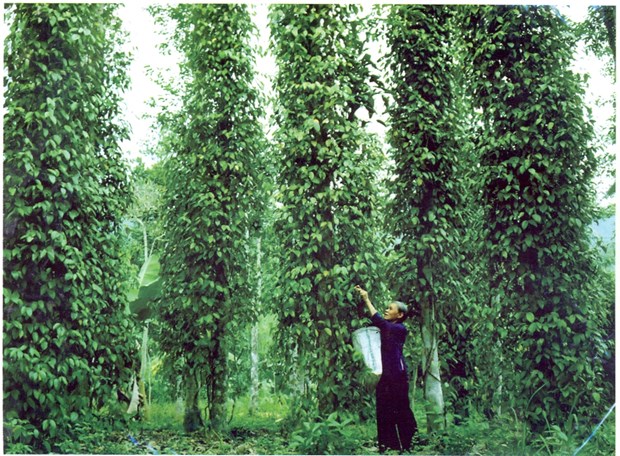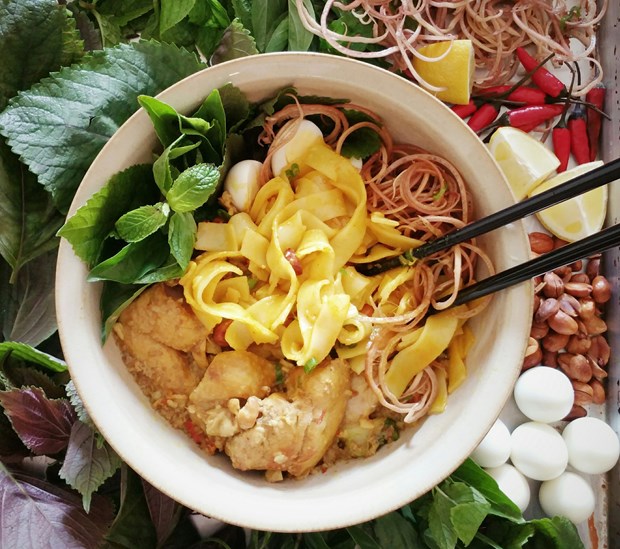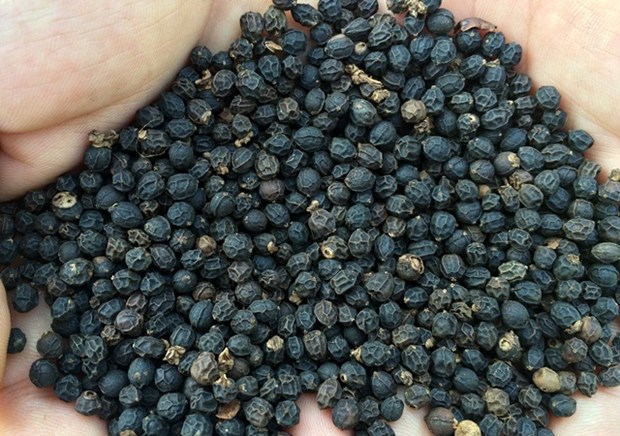Playing an indispensable role in daily meals of locals, black peppers in Tien Phuoc (Quang Nam province) has become the most famous specialty which were traded through Hoi An port to western Europe and Japan since 17th century.
Being
cultivated hundred years ago but farming area and quantity of black pepper in
Tien Phuoc are quite low and only at household scale. Farmers here have been
raising black pepper mostly by their own experiences run in family. Harsh
weather and soil conditions do not allow pepper vines to grow widely but such
strict standards of the nature do create a special type of firm, pungent and
flavorful black peppercorns.

Black pepper vines in a household’s garden. Photo: tienphuoc.quangnam.gov.vn
Black
pepper in Tien Phuoc is mostly domestic type, which has small-dark-green leaves
and short yet dense spikes. The plants are propagated by cuttings about 40 to
50cm long, tied up to neighboring trees or climbing frames about 7 – 10m high
and they’ll live together up to 40 years. This typical kind of black pepper is
really picky so that farmers here need to take a very meticulous care of them.
Mr. Tu Chau (Tien My town) said, “Planting a pepper vine is like to take care
of a child. Must follow it closely. Otherwise it will die after just a couple
months.” Beside watering and pest controlling, fertilizers are the prerequisite
that define quality of final peppercorns. Locals here usually have used organic
manure. Mr. Chau said, “We only use manure. We don’t use fertilizer because I
think natural stuff is always better.” People have admired his lush pepper back
yard with more than 200 units. They all understand that under the harsh climate
here, those pepper vines are results of huge work and effort.
For
the beginning of civilization, black pepper has been used as a spice and natural
medicine widely on the world. In China, black peppercorns are made to patches
for asthma; in India, people use peppercorns to treat cholera and to improve
health after sickness or fever; Indonesians use black peppercorns as a
component of health supplements and pain relief pills, especially for women
after giving birth; in Nepal, black pepper is used with other natural medicine
to treat flu and cold, undigested symptom, or arthritic; and Russian
physiotherapists have proved that taking a bath tub with some drops of black
pepper extract oil can refresh the body and mind.
Locals
in Tien Phuoc, during their culinary progressing, have realized that black
peppercorns also can treat common sickness. Old people usually have a bottle of
peppercorn wine for digestive problems. The recipe is quite simple; we just
need 50g cleaned black peppercorns soaking with 500ml pure white wine; cover
and seal the bottle, place in dry and airy place. This medical wine should be
ready after 6 months but the longer we keep, the better it is. During winter
and cold days, just chewing half of a peppercorn can warm you up. Another
example is that when you have a cold, all you need is a bowl of really hot
congee with green onion and smashed peppercorn relish. That combination can make
you sweat and wake up your digestive system, senses, and the whole body.
Besides
folk experiences, oriental medicine also believes that peppercorn can warm the
abdomen and stimulate digestion, treat nausea, ease pain, and cause gastritis;
black pepper wine is also used as massage liquid to treat muscle-ache or
osteoarthritis pain.
To
treat Rheumatism, soak peppercorn, anise, and alum in pure white wine then use
the wine as massage liquid. To treat toothache, rubbing pepper powder at the
root can ease the pain and kill bacteria. To treat digestive problems, cook
congee with a lot of pepper powder and have it hot. To reduce cramp in period,
swallow 1g of pepper powder with a small glass of warm wine.
They
way people use seasonings can reflect local lifestyle, especially at the
central Viet Nam. They have their own products of spices and they let those
products play significant roles in daily life. Besides salty fish sauce,
buttery peanut oil, aromatic chive root tube, and colorful turmeric, peppercorns
fill the last blank of a basic map of spice with their pungent taste, which can
reduce fishy smell, enrich flavors of seasoned meat, and balance yin-yang
within a dish. Peppercorns work well with any dish – grilled, steamed, or even
a boiled soup. Especially, with local people in Quang Nam province, black
peppercorn is a “must have” seasoning in their specialties, such as Quảng
noodles, steamed beef paste, or chicken rice.

Pork in Quảng noodles is always seasoned with crushed black peppercorn.
To
push the pungent flavor of peppercorns to the highest, farmers here only choose
ripe drupes from pepper vines and dry them under the sun until drained. Dried
peppercorns are stored in glass jars. When needed, they take enough
peppercorns, crush them then marinate raw ingredients or cooking dishes.

Finished dried black peppercorns. Photo: Quang Ngai Newspaper
Not
as big as Phu Quoc or Lam Dong peppercorns (the 2 famous types in Viet Nam) but
quality of Tien Phuoc peppercorns is not less than other types at all, even it
might be better. Outstanding quality of this type of peppercorn is caused by
authentic species and natural conditions, which are regional soil, water, and
climate. However, range of pepper farming in Tien Phuoc is quite small and
within households only, from some to about a hundred units. Farmers have no new
techniques but they all have stuck with extensive culture so that their
productivity is low. High value but low supply has pushed the price of Tien
Phuoc peppercorn up to $25 - $35 per kg at site, which is about 5 to 7 times of
other areas’ products like Daklak or Gia Lai in 2016, 2017.
Although
peppercorns in Tien Phuoc have brought high value and uses to the economic,
medical, and of course culinary fields, to develop and expand farming areas
have faced big difficulties, especially branding process. Hopefully one day,
the aromatic pungent peppercorns of Tien Phuoc can make a path to common
markets and play the role it should be on Vietnamese map of spices.
By Thu Pham